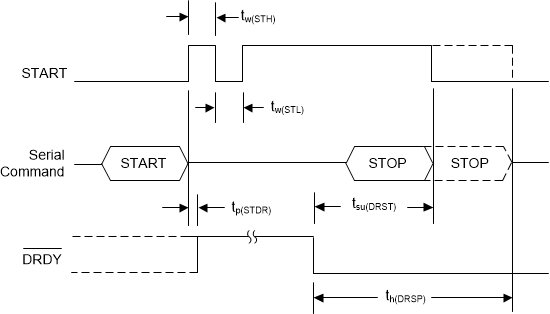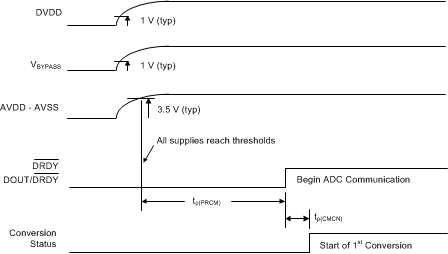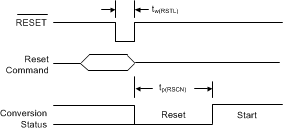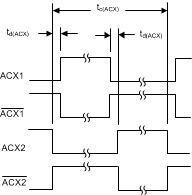JAJSF13C March 2018 – January 2019 ADS1260 , ADS1261
PRODUCTION DATA.
- 1 特長
- 2 アプリケーション
- 3 概要
- 4 改訂履歴
- 5 概要(続き)
- 6 Device Comparison Table
- 7 Pin Configuration and Functions
- 8 Specifications
- 9 Parameter Measurement Information
-
10Detailed Description
- 10.1 Overview
- 10.2 Functional Block Diagram
- 10.3 Feature Description
- 10.4
Device Functional Modes
- 10.4.1 Conversion Control
- 10.4.2 Chop Mode
- 10.4.3 AC-Excitation Mode
- 10.4.4 ADC Clock Mode
- 10.4.5 Power-Down Mode
- 10.4.6 Reset
- 10.4.7 Calibration
- 10.5 Programming
- 10.6
Register Map
- 10.6.1 Device Identification (ID) Register (address = 00h) [reset = xxh]
- 10.6.2 Device Status (STATUS) Register (address = 01h) [reset = 01h]
- 10.6.3 Mode 0 (MODE0) Register (address = 02h) [reset = 24h]
- 10.6.4 Mode 1 (MODE1) Register (address = 03h) [reset = 01h]
- 10.6.5 Mode 2 (MODE2) Register (address = 04h) [reset = 00h]
- 10.6.6 Mode 3 (MODE3) Register (address = 05h) [reset = 00h]
- 10.6.7 Reference Configuration (REF) Register (address = 06h) [reset = 05h]
- 10.6.8 Offset Calibration (OFCALx) Registers (address = 07h, 08h, 09h) [reset = 00h, 00h, 00h]
- 10.6.9 Full-Scale Calibration (FSCALx) Registers (address = 0Ah, 0Bh, 0Ch) [reset = 00h, 00h, 40h]
- 10.6.10 IDAC Multiplexer (IMUX) Register (address = 0Dh) [reset = FFh]
- 10.6.11 IDAC Magnitude (IMAG) Register (address = 0Eh) [reset = 00h]
- 10.6.12 Reserved (RESERVED) Register (address = 0Fh) [reset = 00h]
- 10.6.13 PGA Configuration (PGA) Register (address = 10h) [reset = 00h]
- 10.6.14 Input Multiplexer (INPMUX) Register (address = 11h) [reset = FFh]
- 10.6.15 Input Bias (INPBIAS) Register (address = 12h) [reset = 00h]
- 11Application and Implementation
- 12Power Supply Recommendations
- 13Layout
- 14デバイスおよびドキュメントのサポート
- 15メカニカル、パッケージ、および注文情報
パッケージ・オプション
デバイスごとのパッケージ図は、PDF版データシートをご参照ください。
メカニカル・データ(パッケージ|ピン)
- RHB|32
サーマルパッド・メカニカル・データ
発注情報
8.7 Switching Characteristics
over operating ambient temperature range, DVDD = 2.7 V to 5.25 V, and DOUT/DRDY load: 20 pF || 100 kΩ to DGND (unless otherwise noted); see Figure 8 Figure 1. Serial Interface Timing Requirements
Figure 1. Serial Interface Timing Requirements  Figure 2. Serial Interface Switching Characteristics
Figure 2. Serial Interface Switching Characteristics  Figure 3. Serial Interface Auto-Reset Characteristics
Figure 3. Serial Interface Auto-Reset Characteristics  Figure 4. Conversion Control Timing Requirements
Figure 4. Conversion Control Timing Requirements  Figure 5. Power-Up Characteristics
Figure 5. Power-Up Characteristics  Figure 6. RESET pin and RESET Command Timing Requirements
Figure 6. RESET pin and RESET Command Timing Requirements  Figure 7. AC-Excitation Timing Characteristics
Figure 7. AC-Excitation Timing Characteristics  Figure 8. Timing Voltage-Level Reference
Figure 8. Timing Voltage-Level Reference